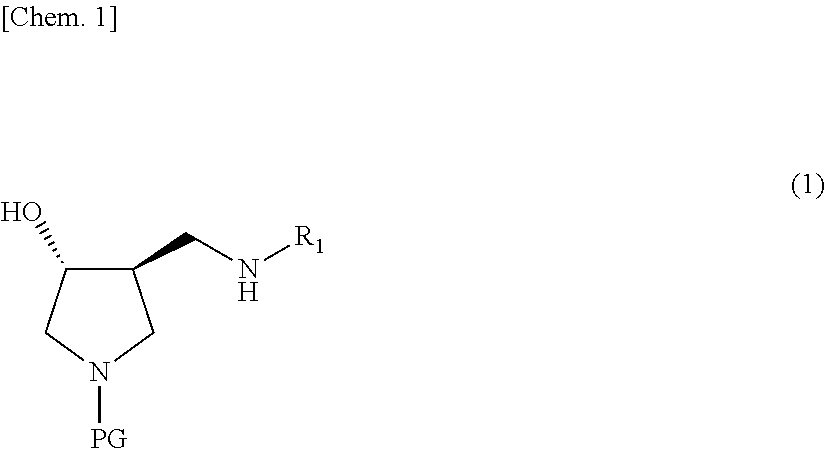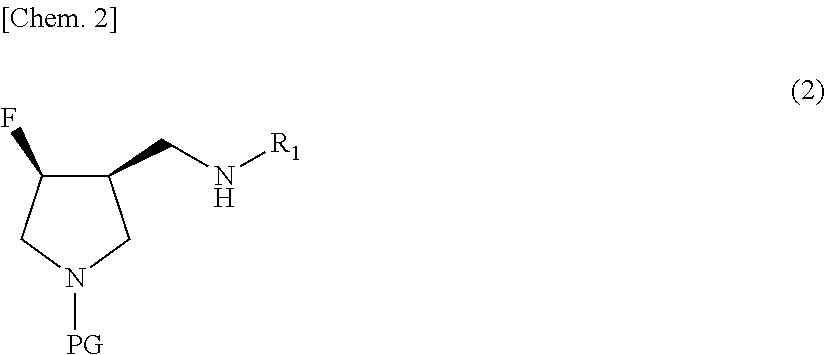Method for producing 3,4-disubstituted pyrrolidine derivative and production intermediate thereof
a technology of pyrrolidine and substituted pyrrolidine, which is applied in the direction of bulk chemical production, antibacterial agents, organic chemistry, etc., can solve the problems of reduced yield, difficult purification, and undesirable effects, and achieve the effect of inexpensive production
- Summary
- Abstract
- Description
- Claims
- Application Information
AI Technical Summary
Benefits of technology
Problems solved by technology
Method used
Image
Examples
example 1
[0139]Benzyl (3S,4R)-3-(cyclopropylaminomethyl)-4-hydroxypyrrolidine-1-carboxylate obtained by the method described in Reference Example was dissolved in a solvent (acetonitrile, 6 multiples). A fluorinating agent (Deoxo-Fluor, 4 equivalents) was added at an internal temperature of −5 to 5° C., followed by stirring at an internal temperature of −5 to 5° C. for 1 hour, and the temperature was raised, followed by stirring at an internal temperature of 10 to 20° C. for 7 hours, and then left standing overnight at room temperature (Table 1). The reaction solution was subjected to measurements using HPLC. The results are listed in Table 7.
example 2
[0140]Benzyl (3S,4R)-3-(cyclopropylaminomethyl)-4-hydroxypyrrolidine-1-carboxylate obtained by the method described in Reference Example was dissolved in a solvent (acetonitrile, 6 multiples). Thereafter, an additive (triethylamine pentahydrofluoride, 2 equivalents) was added at an internal temperature of −5 to 10° C., followed by stirring at an internal temperature of −5 to 5° C. for 0.5 hours. Then, a fluorinating agent (Deoxo-Fluor) was added at an internal temperature of −5 to 5° C., following by stirring at an internal temperature of −5 to 5° C. for 1 hour, and the temperature was then raised, followed by stirring at an internal temperature of 10 to 20° C. for 7 hours, and then left standing overnight at room temperature (Table 1). The reaction solution was subjected to measurements using HPLC. The results are listed in Table 7.
examples 3 to 7
[0141]This reaction was performed in the same manner as in Example 2 using fluorinating agents, additives and solvents listed in Table 1. The reaction solution was subjected to measurements using HPLC. The results are listed in Table 7.
TABLE 1Fluorinating agentAdditive(Equivalent)(Equivalent)SolventExample 1Deoxo-Fluor (4.0)—CH3CNExample 2Deoxo-Fluor (4.0)5HF•Et3N (2.0)CH3CNExample 3Deoxo-Fluor (1.2)5HF•Et3N (10.0)TolueneExample 4DAST (1.2)5HF•Et3N (10.0)TolueneExample 5DAST (1.2)5HF•Et3N (4.0)TolueneExample 6Morpho-DAST (1.2)5HF•Et3N (4.0)TolueneExample 7Deoxo-Fluor (1.2)5HF•Et3N (4.0)Toluene
PUM
| Property | Measurement | Unit |
|---|---|---|
| Fraction | aaaaa | aaaaa |
| Electrical conductance | aaaaa | aaaaa |
| Equivalent mass | aaaaa | aaaaa |
Abstract
Description
Claims
Application Information
 Login to View More
Login to View More - R&D
- Intellectual Property
- Life Sciences
- Materials
- Tech Scout
- Unparalleled Data Quality
- Higher Quality Content
- 60% Fewer Hallucinations
Browse by: Latest US Patents, China's latest patents, Technical Efficacy Thesaurus, Application Domain, Technology Topic, Popular Technical Reports.
© 2025 PatSnap. All rights reserved.Legal|Privacy policy|Modern Slavery Act Transparency Statement|Sitemap|About US| Contact US: help@patsnap.com



